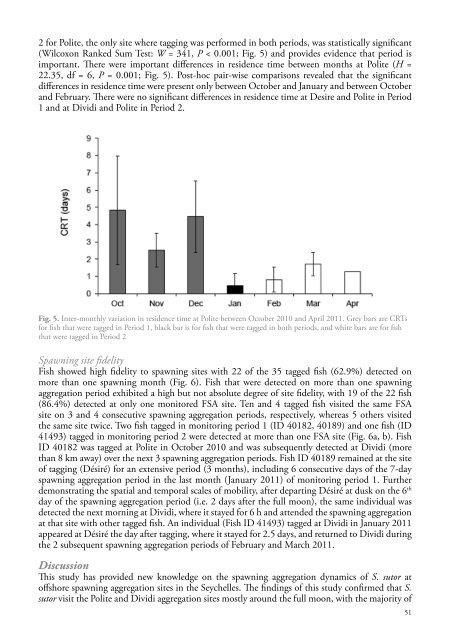WIOMSA-CORDIO spawning book Full Doc 10 oct 13.pdf
WIOMSA-CORDIO spawning book Full Doc 10 oct 13.pdf
WIOMSA-CORDIO spawning book Full Doc 10 oct 13.pdf
Create successful ePaper yourself
Turn your PDF publications into a flip-book with our unique Google optimized e-Paper software.
2 for Polite, the only site where tagging was performed in both periods, was statistically significant(Wilcoxon Ranked Sum Test: W = 341, P < 0.001; Fig. 5) and provides evidence that period isimportant. There were important differences in residence time between months at Polite (H =22.35, df = 6, P = 0.001; Fig. 5). Post-hoc pair-wise comparisons revealed that the significantdifferences in residence time were present only between October and January and between Octoberand February. There were no significant differences in residence time at Desire and Polite in Period1 and at Dividi and Polite in Period 2.Fig. 5. Inter-monthly variation in residence time at Polite between October 20<strong>10</strong> and April 2011. Grey bars are CRTsfor fish that were tagged in Period 1, black bar is for fish that were tagged in both periods, and white bars are for fishthat were tagged in Period 2Spawning site fidelityFish showed high fidelity to <strong>spawning</strong> sites with 22 of the 35 tagged fish (62.9%) detected onmore than one <strong>spawning</strong> month (Fig. 6). Fish that were detected on more than one <strong>spawning</strong>aggregation period exhibited a high but not absolute degree of site fidelity, with 19 of the 22 fish(86.4%) detected at only one monitored FSA site. Ten and 4 tagged fish visited the same FSAsite on 3 and 4 consecutive <strong>spawning</strong> aggregation periods, respectively, whereas 5 others visitedthe same site twice. Two fish tagged in monitoring period 1 (ID 40182, 40189) and one fish (ID41493) tagged in monitoring period 2 were detected at more than one FSA site (Fig. 6a, b). FishID 40182 was tagged at Polite in October 20<strong>10</strong> and was subsequently detected at Dividi (morethan 8 km away) over the next 3 <strong>spawning</strong> aggregation periods. Fish ID 40189 remained at the siteof tagging (Désiré) for an extensive period (3 months), including 6 consecutive days of the 7-day<strong>spawning</strong> aggregation period in the last month (January 2011) of monitoring period 1. Furtherdemonstrating the spatial and temporal scales of mobility, after departing Désiré at dusk on the 6 thday of the <strong>spawning</strong> aggregation period (i.e. 2 days after the full moon), the same individual wasdetected the next morning at Dividi, where it stayed for 6 h and attended the <strong>spawning</strong> aggregationat that site with other tagged fish. An individual (Fish ID 41493) tagged at Dividi in January 2011appeared at Désiré the day after tagging, where it stayed for 2.5 days, and returned to Dividi duringthe 2 subsequent <strong>spawning</strong> aggregation periods of February and March 2011.DiscussionThis study has provided new knowledge on the <strong>spawning</strong> aggregation dynamics of S. sutor atoffshore <strong>spawning</strong> aggregation sites in the Seychelles. The findings of this study confirmed that S.sutor visit the Polite and Dividi aggregation sites mostly around the full moon, with the majority of51


















